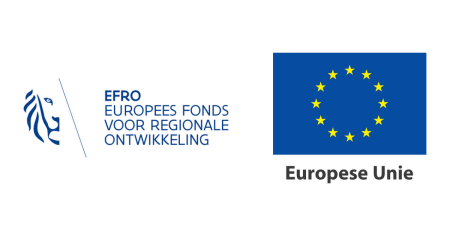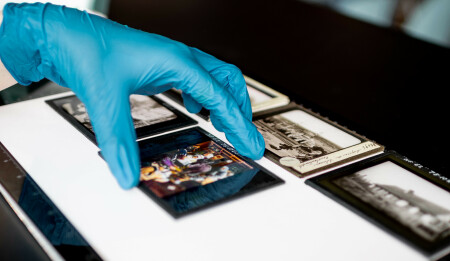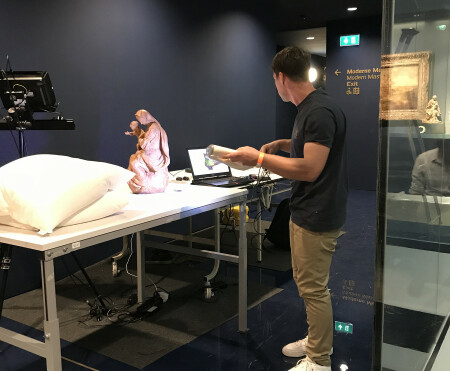Glass plates spotted: a late summer update
29 Sep 2022
In the ‘Gecoördineerd Initiatief voor Vlaamse Erfgoeddigitalisering’ (GIVE – Coordinated Initiative for Flemish Heritage Digitisation), we’re investigating how to add metadata automatically and digitising a lot of newspapers, glass plates and masterpieces. Our previous update was as recent as June, but we’ve been busy over the summer months. From 3D copies of sculptures to glass plates in the news, we again have much to report in this third GIVE bulletin.
The GIVE projects have been made possible thanks to support from the European Regional Development Fund (ERDF) (link in Dutch) and are part of the Flemish Government’s ‘Resilience Recovery Plan’ (link in Dutch).
Glass plates rolling off the press
If you happened to read the newspaper on 19th August, you might have spotted an article on our GIVE glass plates project. To commemorate World Photography Day, we headed to MAS (Museum aan de Stroom) on 18th August, where we set things in motion for the mass digitisation of photos on glass plates. Read the full story in this VRT report (link in Dutch) or our press release.
Starting the digitisation
Digitising glass plates is not a straightforward task, which is why our partner GMS is using a specific method in specially equipped studios.
- Loes Nijsmans, project leader for the GIVE glass plates project
The first batch of glass plates left for the Netherlands, where GMS will take care of the digitisation, in July. A second batch was sent last month, and the in-house digitisation projects being run by Ghent University Boekentoren (‘Book Tower’) and FOMU (Photo Museum Antwerp) will start in a few weeks. Following a test phase, the digitisation will start in earnest this autumn. If everything goes smoothly, we will finish in September 2023. To see what this process look like, watch this short video from GMS.
Don't see a video? Please check your cookie settings so we can show this content to you too.
Edit your cookie preferences hereKnowyourcarrier.com upgrade imminent
At knowyourcarrier.com, you can find out in just a few clicks what audiovisual carrier you have on your hands. And over the past few months, we’ve been working hard to extend our offering to include photographic media
Target audience? Professional photo heritage managers and private individuals.
What stage are we at? We’ve already created a decision tree, based on extensive preliminary research and input from photo experts, which we’re currently fine-tuning.
Next year on knowyourcarrier.com, you will be able to look up information, discover storage and preservation tips, and find out where to go with your photographic materials.
The Flemish masterpieces project within GIVE has been set up to produce high-quality digital reproductions of moveable cultural heritage of exceptional importance. Even though the four different strands in this project (paper and parchment, 2D, 3D, and gigapixel) each require their own approach and schedule, they all have one thing in common: things have been progressing rapidly over the summer.
Ready to start masterpieces on paper and parchment
Consultant Martine Eeckhout completed the condition review over the summer, and concluded that it will be possible to digitise all but one of the 40 masterpieces without any extensive restoration or conservation – great news! We’re currently still fine-tuning the specific digitisation process for the masterpieces, and we will then be working in 11 different locations from next month following on from the test phase at GMS.
Good to know: we’re not conducting the tests on actual masterpieces; they’re far too valuable for that.
KMSKA re-opening sets 2D and 3D in motion
On 24 September, KMSKA – the Royal Museum of Fine Arts Antwerp – was delighted to open its doors to the public again after 11 years of construction and renovation work. No fewer than 40 of the 2D masterpieces in their collection were the first to be photographed to celebrate this special occasion. And KMSKA also used the scanning method to create the first digital 3D copies of 3D masterpieces in its collection. Some sculptures from the Van Herck Collection will appear in the permanent exhibition, which were captured in advance of the reopening. The rest of the images from the collection are scheduled for digitisation at the start of 2023.
See the result in the video below:
Don't see a video? Please check your cookie settings so we can show this content to you too.
Edit your cookie preferences hereFirst steps in gigapixel photography
Over recent months, we’ve taken extremely high-resolution shots of five masterpieces. This special method of photography involves merging several partial shots of the same painting into one large file of at least 1 billion pixels, so you can admire the masterpiece in the finest detail!
What next? We’ll be adding the digitised masterpieces to the artinflanders.be images database over the course of 2023, and researching new ways to unlock IIIF (link in Dutch) over the coming months.
In the GIVE metadata project, together with Ordina and Cronos/Nubiter, we’re investigating how machine learning can help with automatic metadata generation and enrichment. Read a quick summary of how we’re doing this here. We’ll keep the update brief this time:
The metadata working group met for the first time in June, with a second meeting in early October. It’s not too late for any other content partners who are interested in this topic to still join in!
We want to use as much standardisation as possible across the different strands (facial, speech and entity recognition), and have therefore drawn up a design for the architecture and workflows.
We’re still working on the tender for the speech recognition part; we had to stop an initial procedure, but are still planning to make a final choice before the end of this year.
We will finish building or buying face detection and recognition technology next month. Our machine learning consultants are still poring over the results from the FAME project and other open source services (building), and evaluating a number of cloud services (buying).
Together with Flanders Heritage Library, we’re digitising and providing access to 630,000 newspaper pages from eight content partners. The first shipments took place this summer, and there are already three batches of newspapers ready at Picturae in Heerhugowaard. Some technical issues delayed the start of the digitisation production phase by a couple of months, but have not held us back in the meantime:
we’ve made great strides for the registration part, ensuring an uninterrupted supply of newspapers to Picturae;
we’ve also fine-tuned the digitisation process by carefully checking the files supplied to us by Picturae against the set quality requirements – with a 100% success rate so far!
Now what?
We’re planning to archive the first digital files this autumn. Picturae is also using optical character recognition (OCR) on the digital pages to make the text searchable, and providing technical metadata.
Source references banners:
Vrouwen aan het strand van Oostende (1920-30), FOMU
Memorieboek, 2574#69, Archief Sint-Lucasgilde, FelixArchief, publiek domein
Het proces van gezichtsherkenning toegepast op een foto uit de voorstelling ‘Ik wist niet dat Engeland zo mooi was’ van theatergezelschap Radeis. Op de voorgrond zie je Dirk Pauwels en Josse De Pauw. Foto: Michiel Hendryckx, CC BY-SA 4.0
Krantenpagina uit 'Voor allen' (1946), Amsab-ISG


